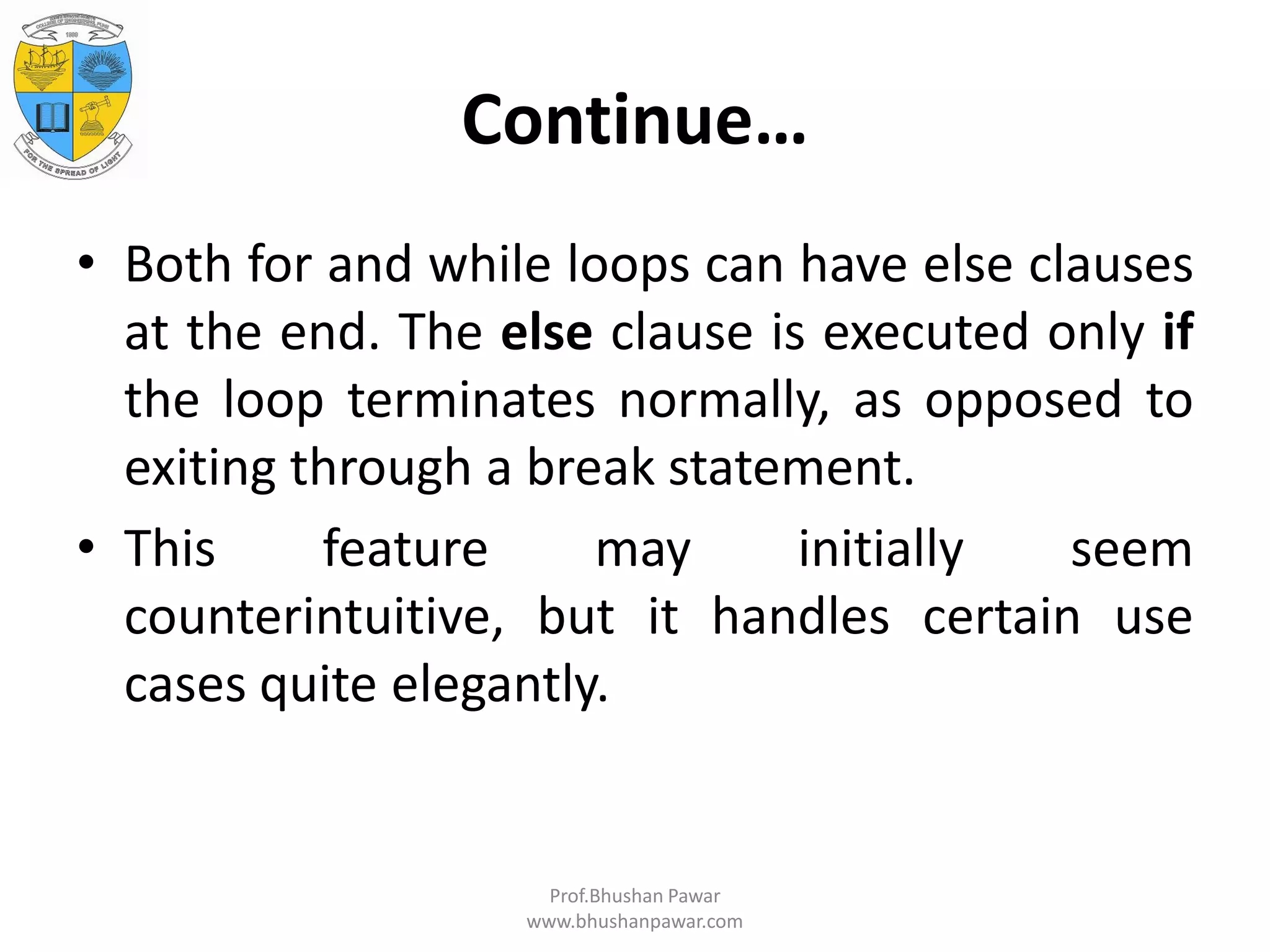This document provides an overview of scripting and shell basics. It discusses common shell commands like cut, sort, uniq, wc, head, tail, tee, grep and pipes. It also covers basic bash scripting, regular expressions, and an introduction to Perl programming. The document is presented as lecture notes covering key topics like shell editing commands, I/O redirection, variables, filters and options for commands.

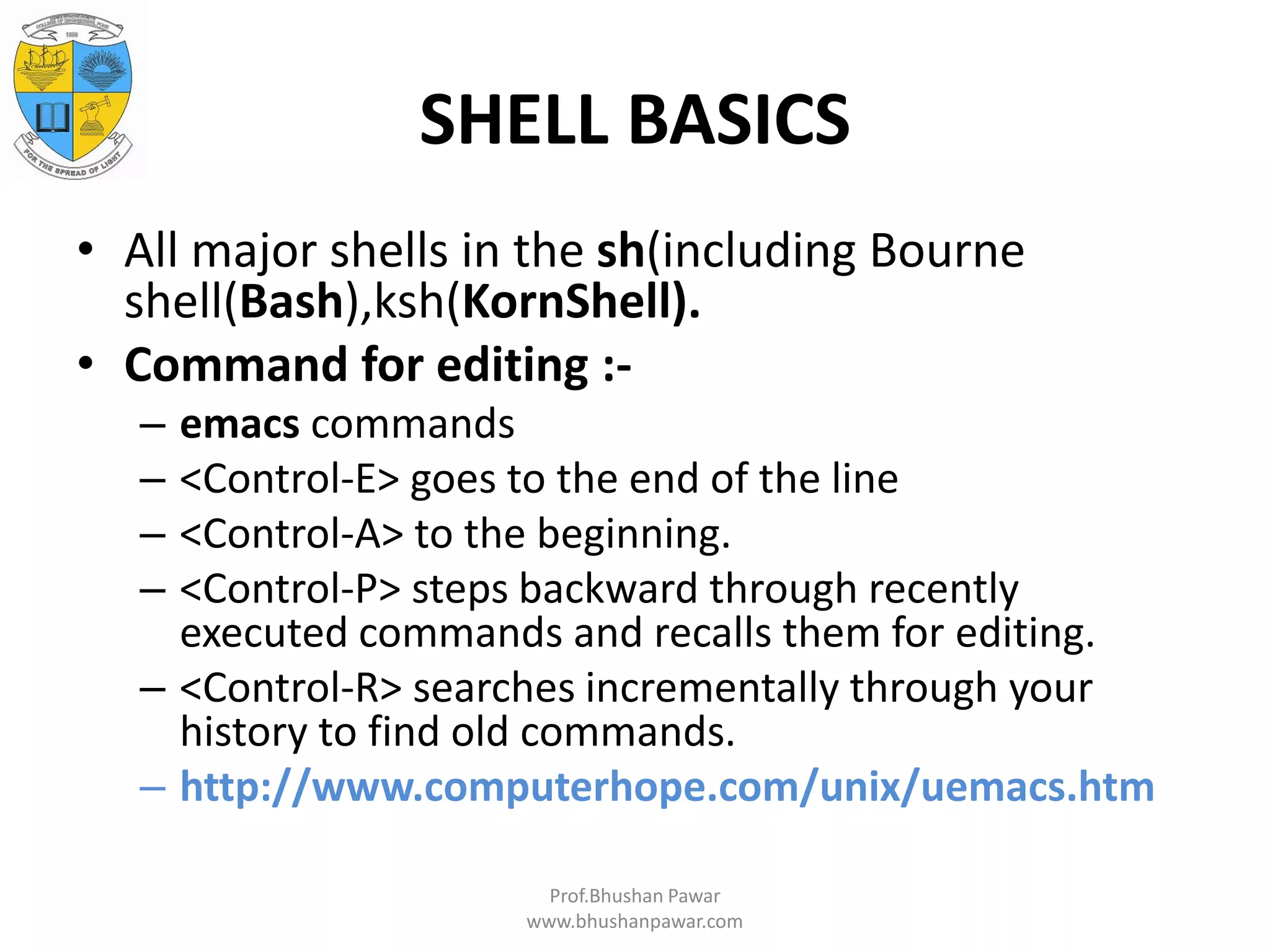

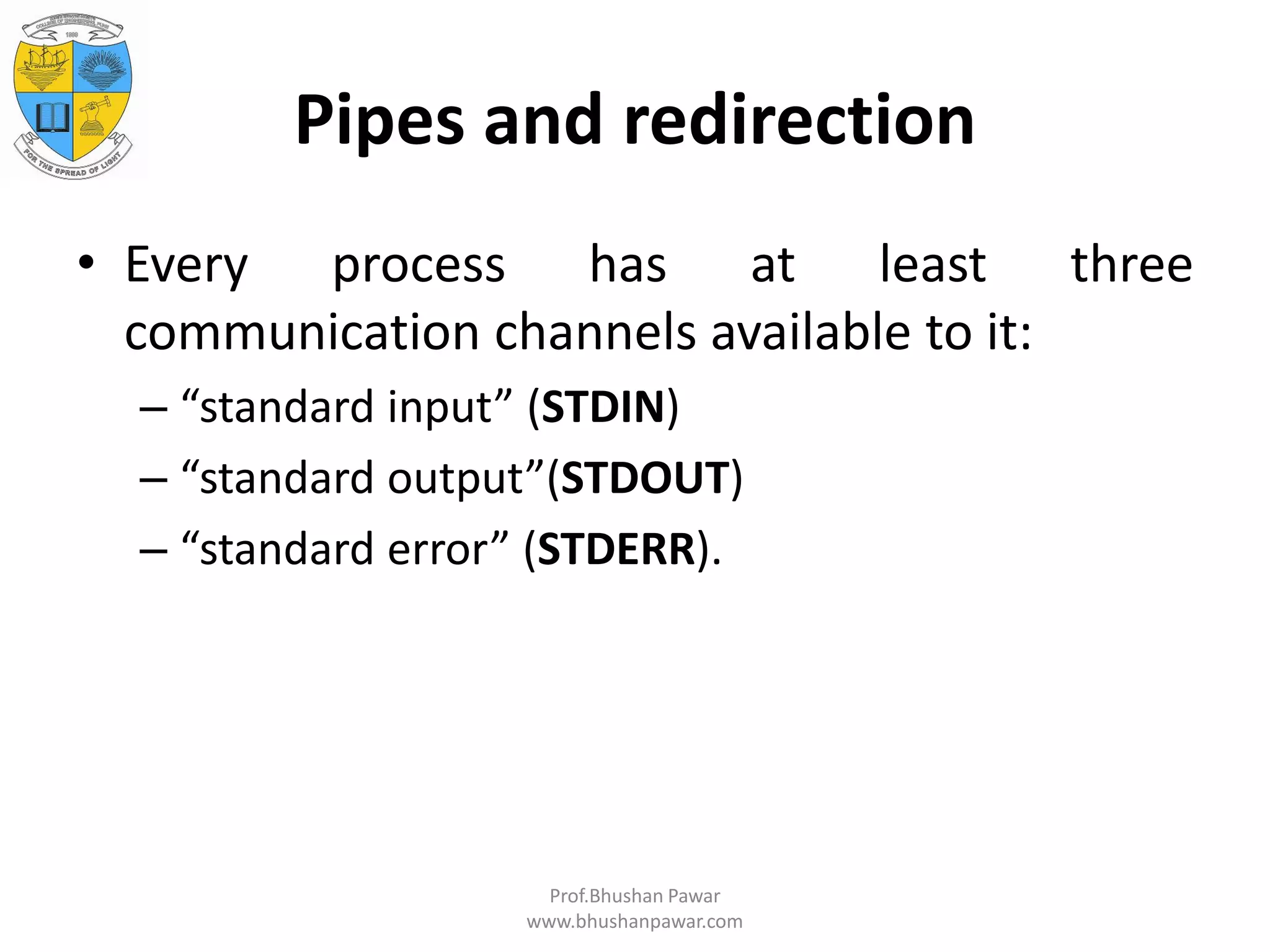
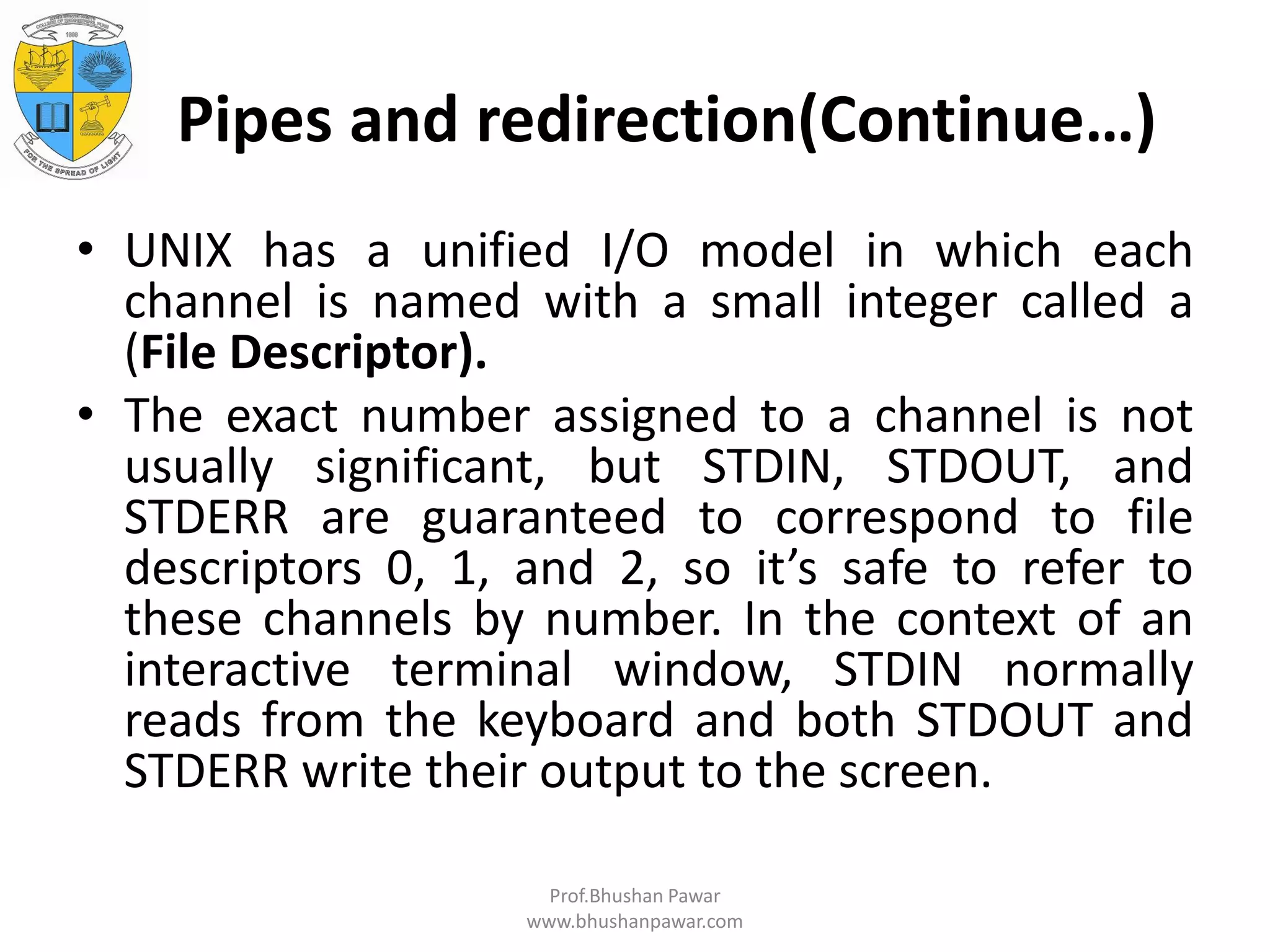
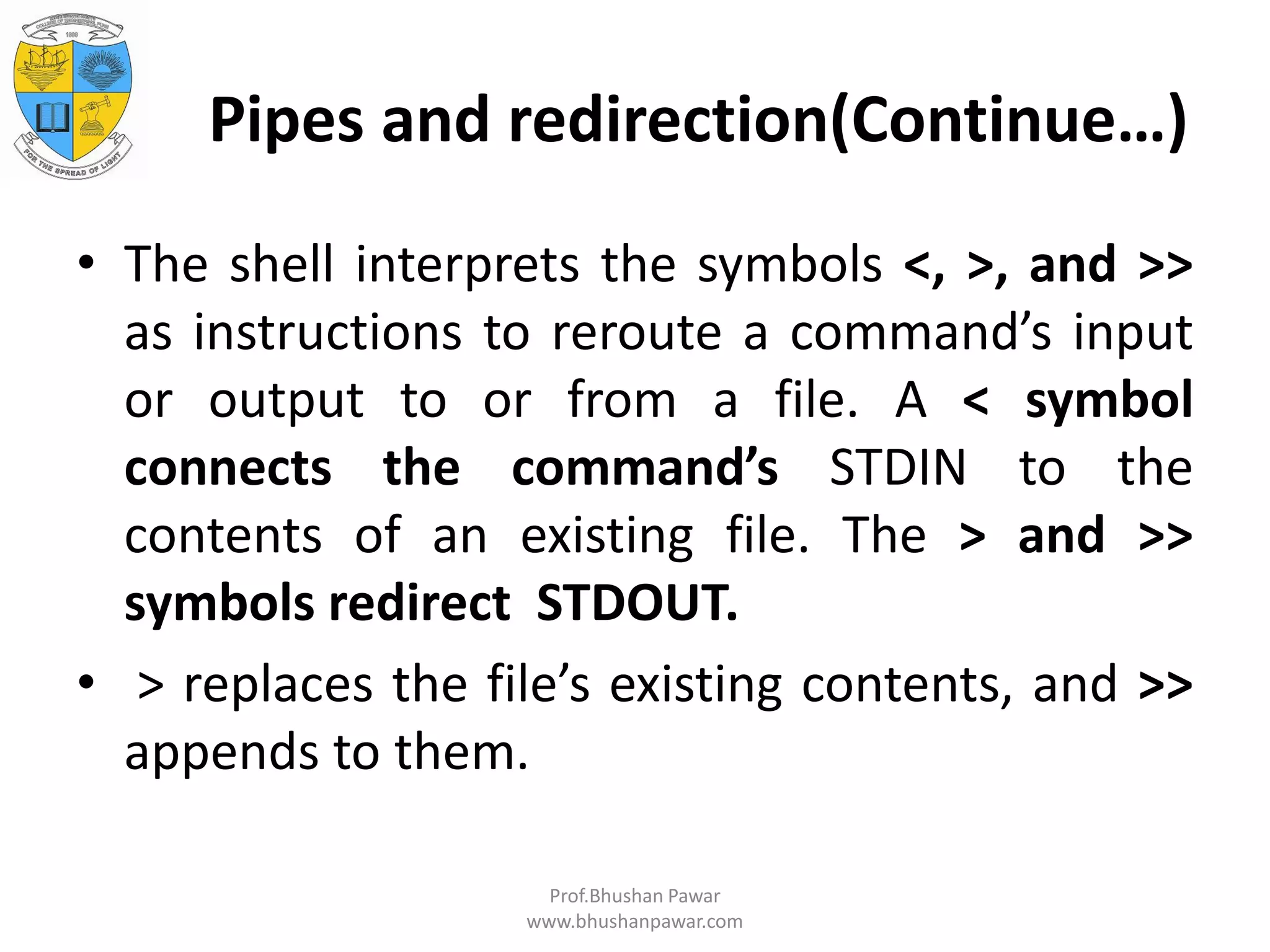



![sort command • Sort: Sort command in unix or linux system is used to order the elements or text. Sort command has the capability of sorting numerical values and strings. – Syntax :- sort [options] filename – (http://www.folkstalk.com/2012/08/sort- command-examples-in-unix-linux.html ) Prof.Bhushan Pawar www.bhushanpawar.com](https://image.slidesharecdn.com/unit4-scriptingandtheshell-150713074847-lva1-app6891/75/Unit-4-scripting-and-the-shell-10-2048.jpg)
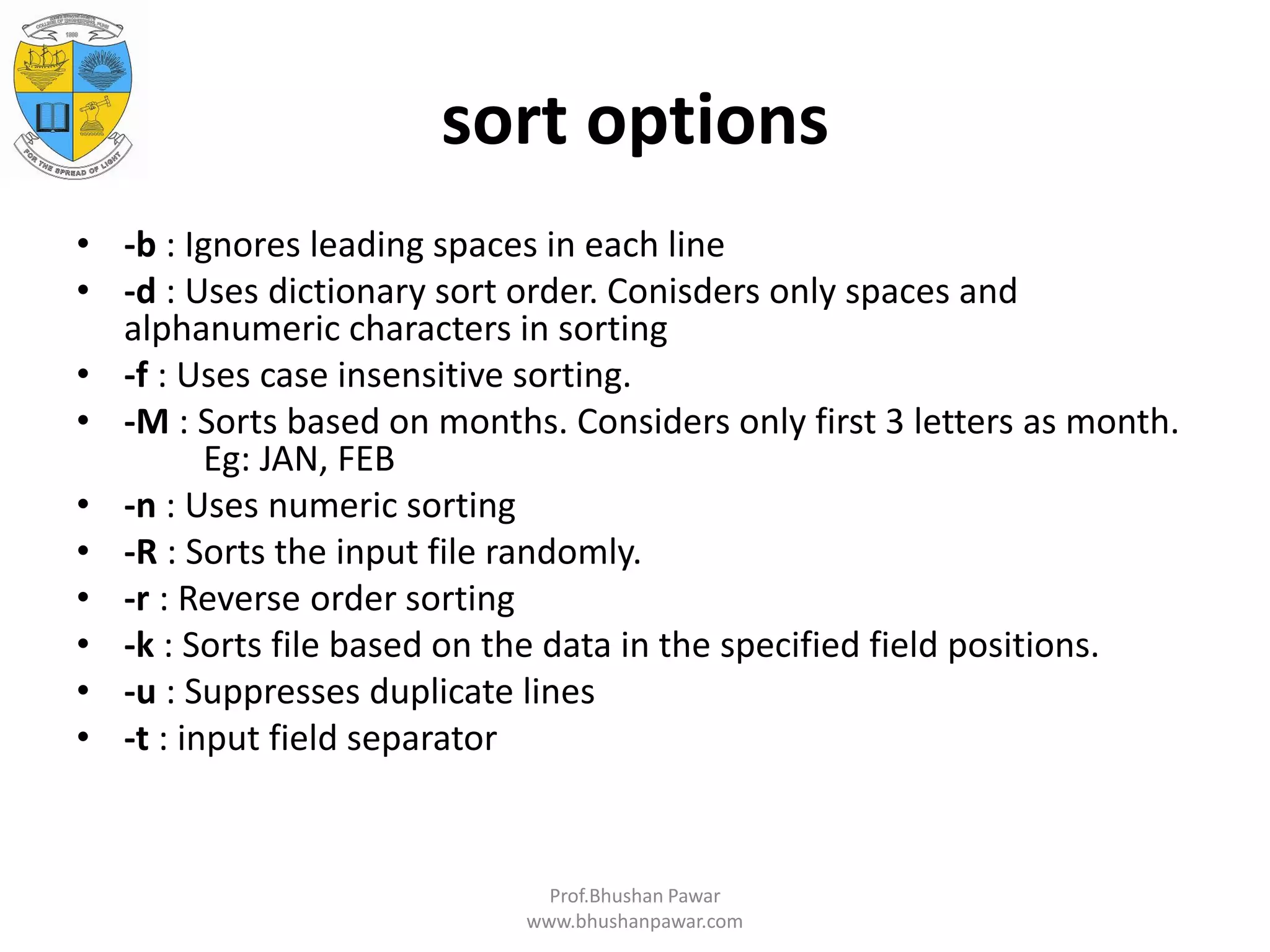
![Uniq command • Uniq command in unix or linux system is used to suppress the duplicate lines from a file • Syntax:- uniq [option] filename – (http://www.folkstalk.com/search?q=uniq+comm and+in+%3Blinux ) Prof.Bhushan Pawar www.bhushanpawar.com](https://image.slidesharecdn.com/unit4-scriptingandtheshell-150713074847-lva1-app6891/75/Unit-4-scripting-and-the-shell-12-2048.jpg)

![wc command • wc command in unix or linux is used to find the number of lines, words and characters in a file. • Syntax :- wc [options] filenames • ( http://www.folkstalk.com/2012/07/wc- command-examples-in-unix-linux.html#more ) Prof.Bhushan Pawar www.bhushanpawar.com](https://image.slidesharecdn.com/unit4-scriptingandtheshell-150713074847-lva1-app6891/75/Unit-4-scripting-and-the-shell-14-2048.jpg)



![head command • The head command reads the first few lines of any text given to it as an input and writes them to standard output (which, by default, is the display screen). • head's basic syntax is: – head [options] [file(s)] ( http://www.linfo.org/head.html ) Prof.Bhushan Pawar www.bhushanpawar.com](https://image.slidesharecdn.com/unit4-scriptingandtheshell-150713074847-lva1-app6891/75/Unit-4-scripting-and-the-shell-18-2048.jpg)
![Options of head command • -c, --bytes=[-]N – print the first N bytes of each file; with the leading '-', print all but the last N bytes of each file • -n, --lines=[-]N – print the first N lines instead of the first 10; with the lead- ing '-', print all but the last N lines of each file • -q, --quiet, --silent – never print headers giving file names • -v, --verbose – always print headers giving file names Prof.Bhushan Pawar www.bhushanpawar.com](https://image.slidesharecdn.com/unit4-scriptingandtheshell-150713074847-lva1-app6891/75/Unit-4-scripting-and-the-shell-19-2048.jpg)
![tail command • tail :-output the last part of files • Syntax :- – tail [OPTION]... [FILE]... (http://linux.about.com/library/cmd/blcmdl1_tail.ht m ) Prof.Bhushan Pawar www.bhushanpawar.com](https://image.slidesharecdn.com/unit4-scriptingandtheshell-150713074847-lva1-app6891/75/Unit-4-scripting-and-the-shell-20-2048.jpg)
![Options of tail command • -c, --bytes=N – output the last N bytes • -f, --follow[={name|descriptor}] – output appended data as the file grows; -f, -- follow, and --follow=descriptor are equivalent • -F – same as --follow=name --retry • -n, --lines=N – output the last N lines, instead of the last 10 Prof.Bhushan Pawar www.bhushanpawar.com](https://image.slidesharecdn.com/unit4-scriptingandtheshell-150713074847-lva1-app6891/75/Unit-4-scripting-and-the-shell-21-2048.jpg)
![grep command • grep :- The grep command allows you to search one file or multiple files for lines that contain a pattern. Exit status is 0 if matches were found, 1 if no matches were found, and 2 if errors occurred. • Syntax – grep [options] pattern [files] (http://www.techonthenet.com/unix/basic/grep.ph p ) Prof.Bhushan Pawar www.bhushanpawar.com](https://image.slidesharecdn.com/unit4-scriptingandtheshell-150713074847-lva1-app6891/75/Unit-4-scripting-and-the-shell-22-2048.jpg)
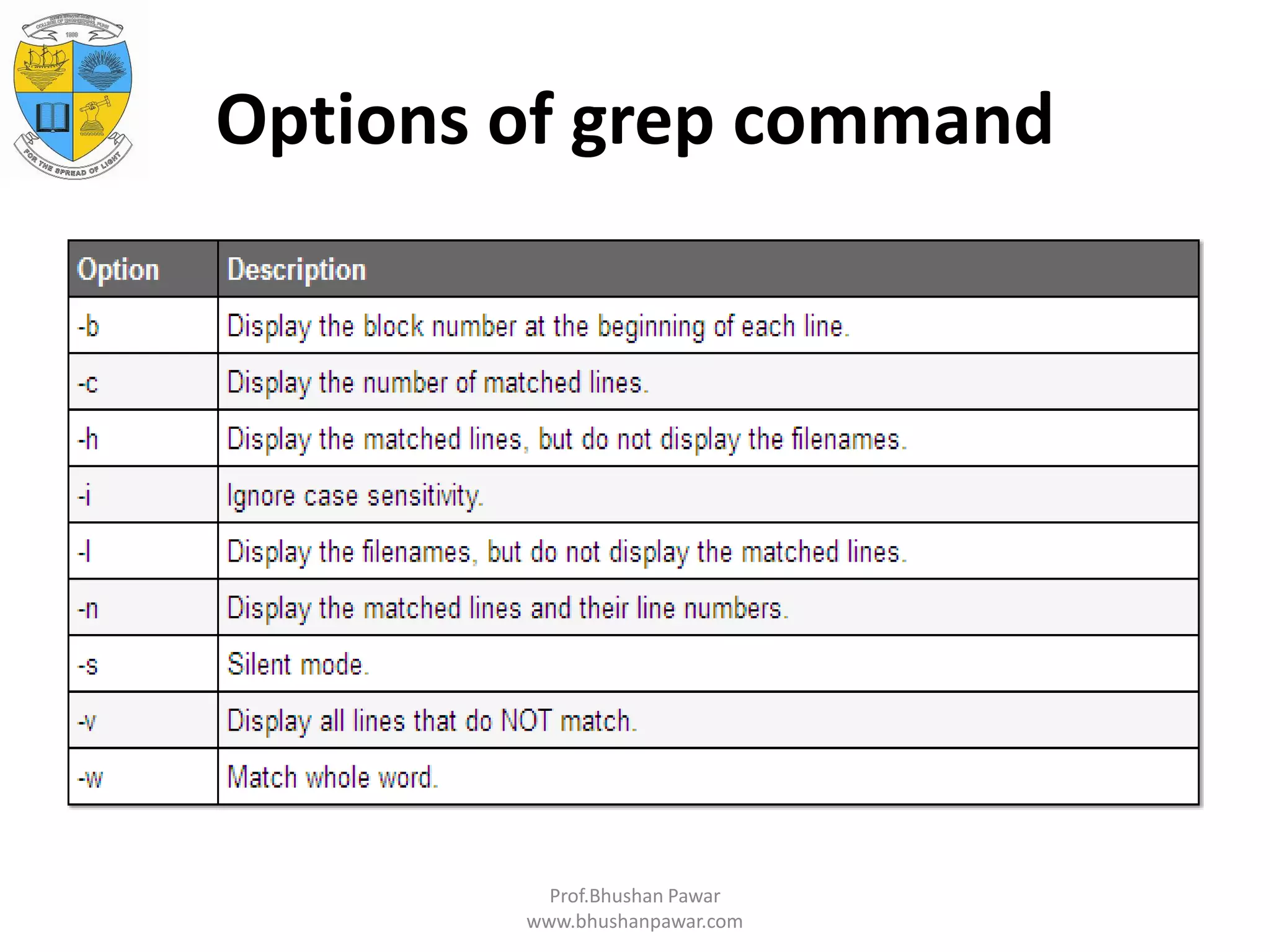

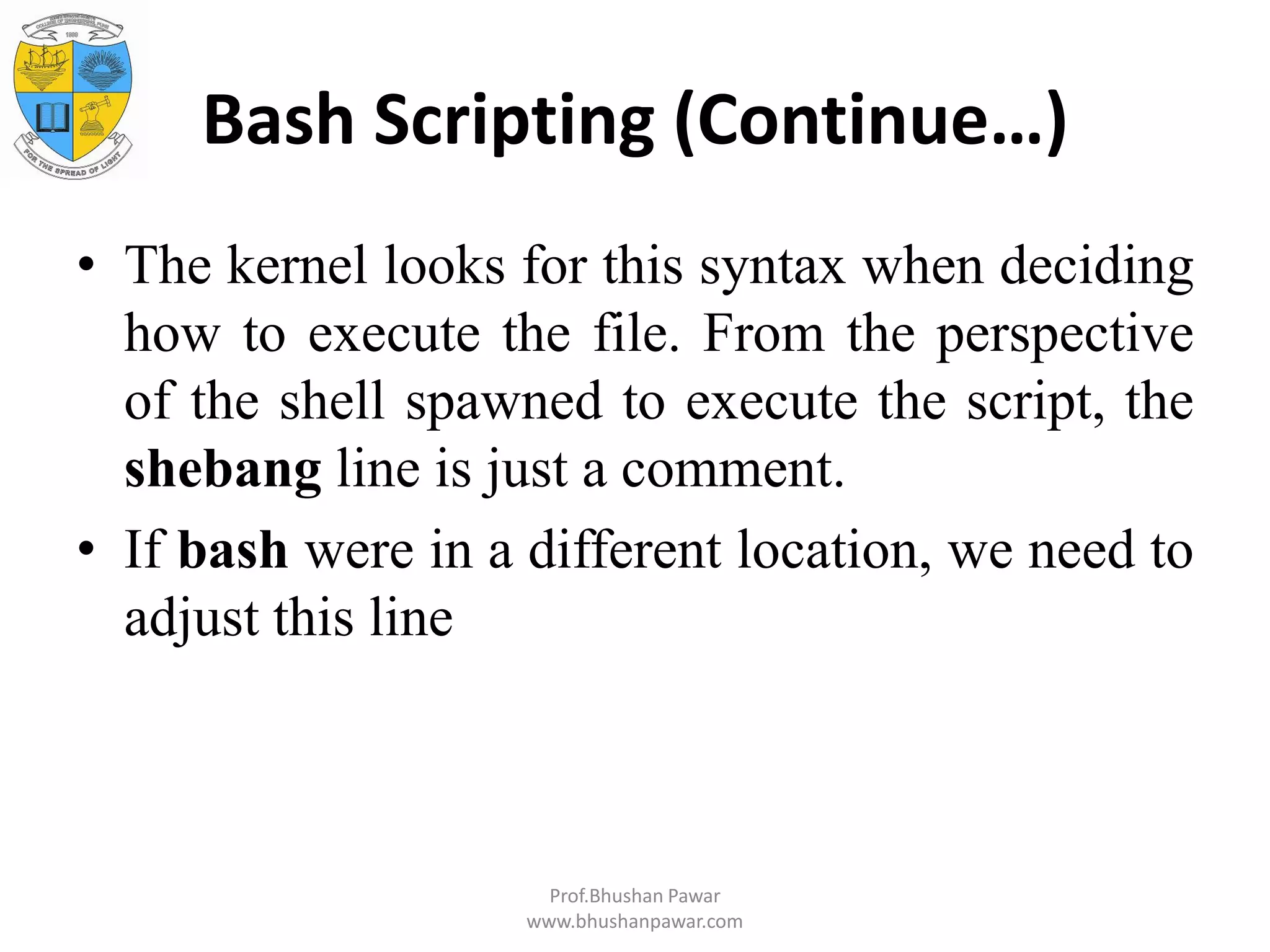



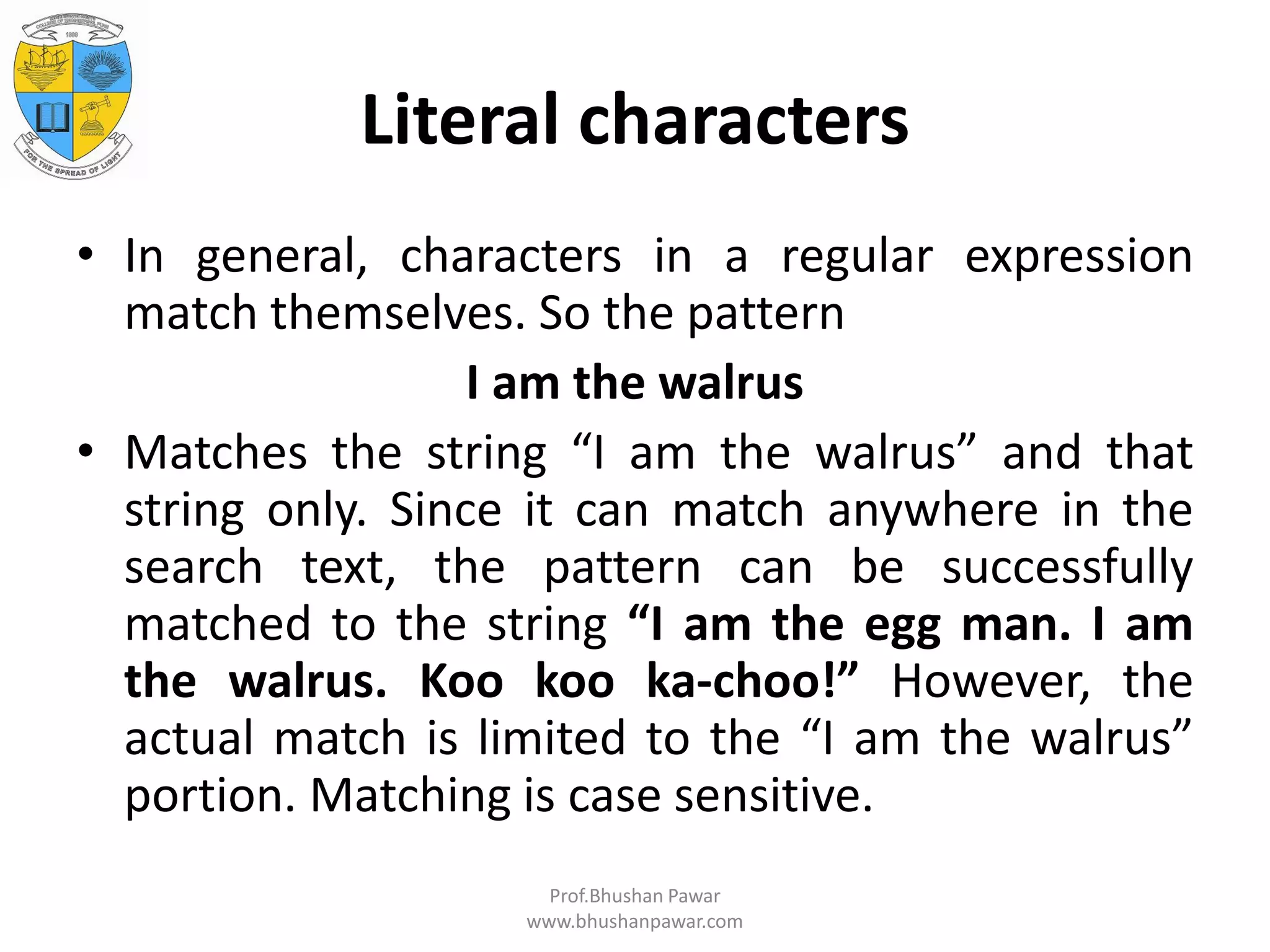
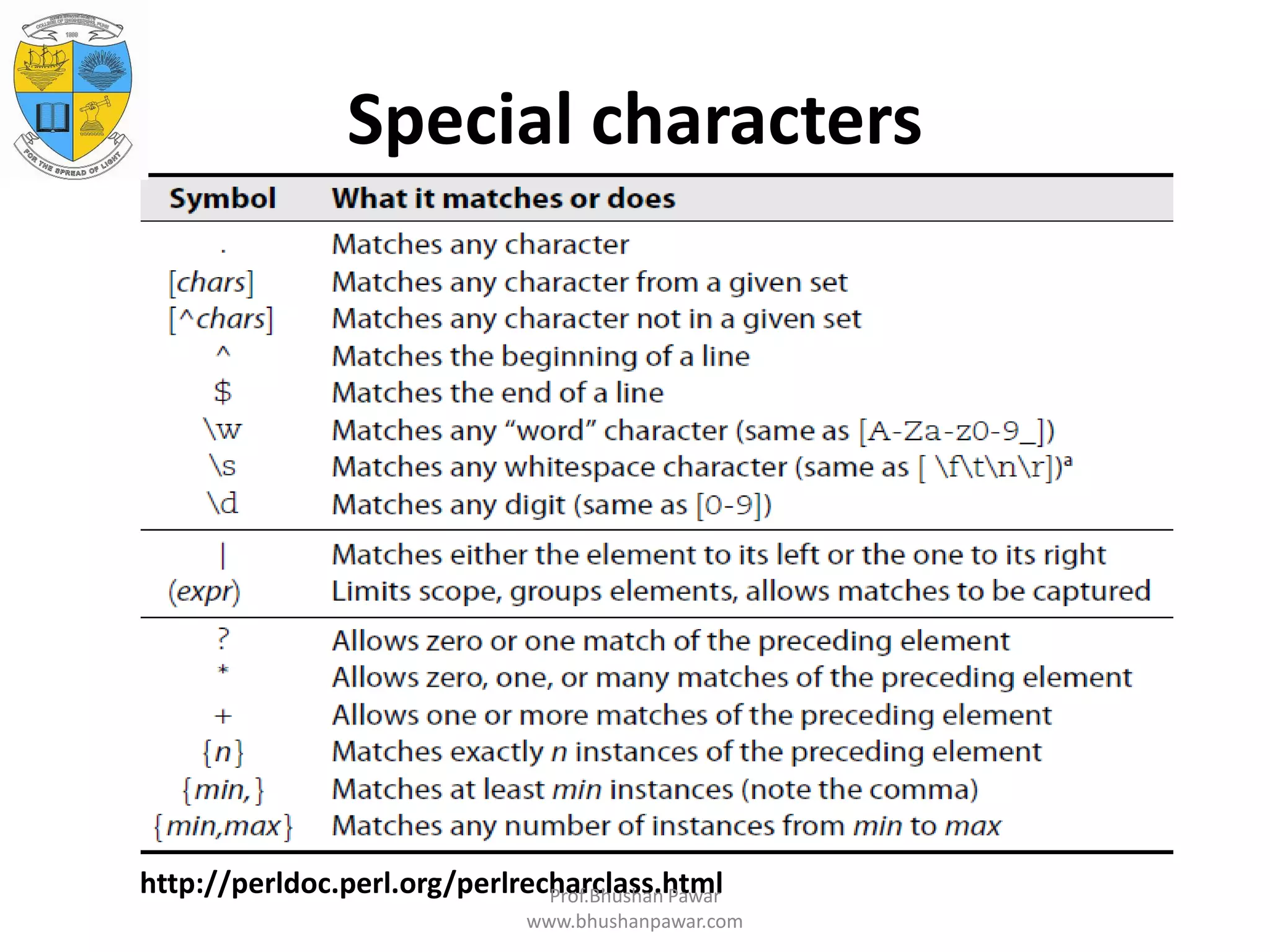
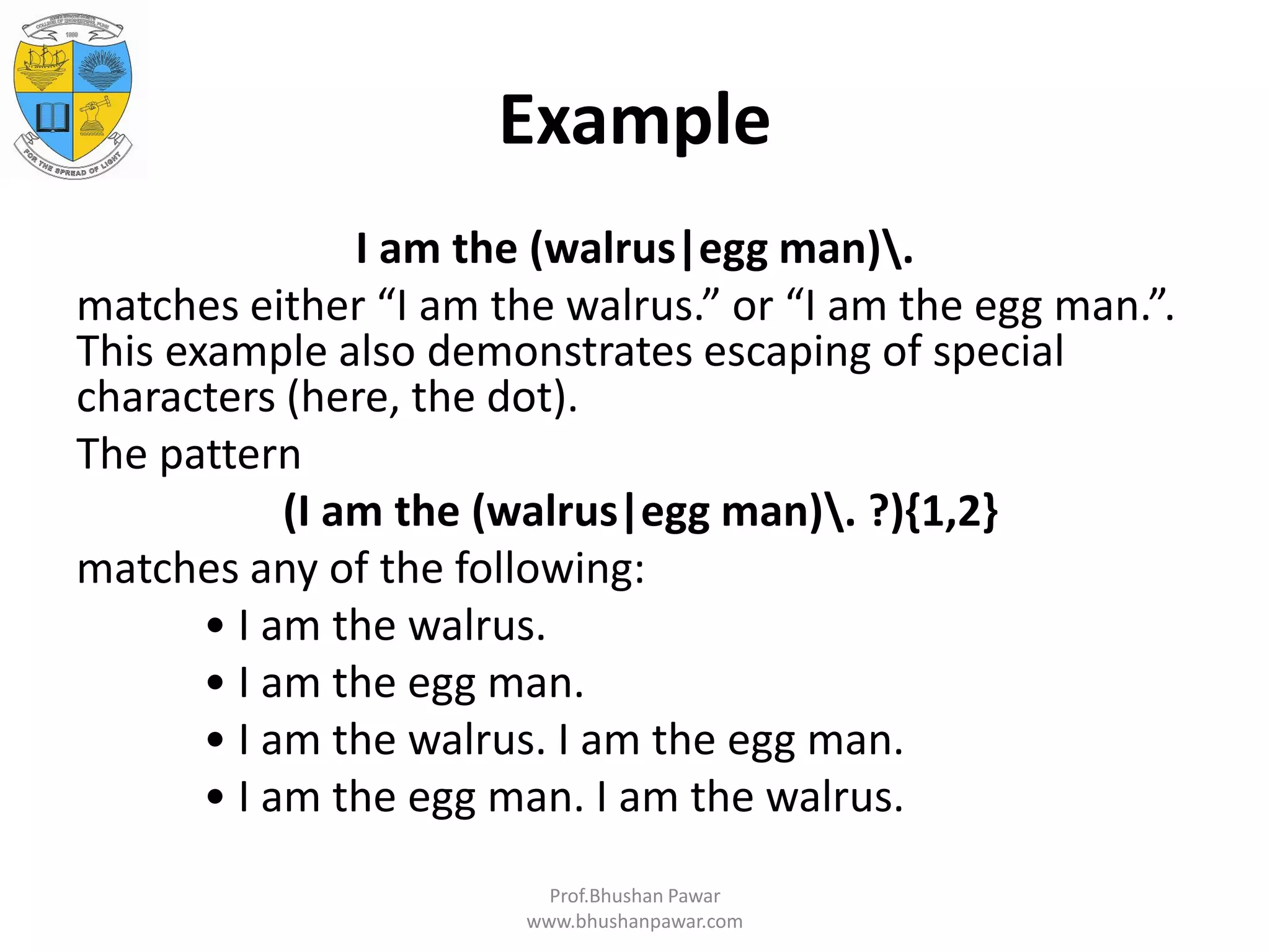
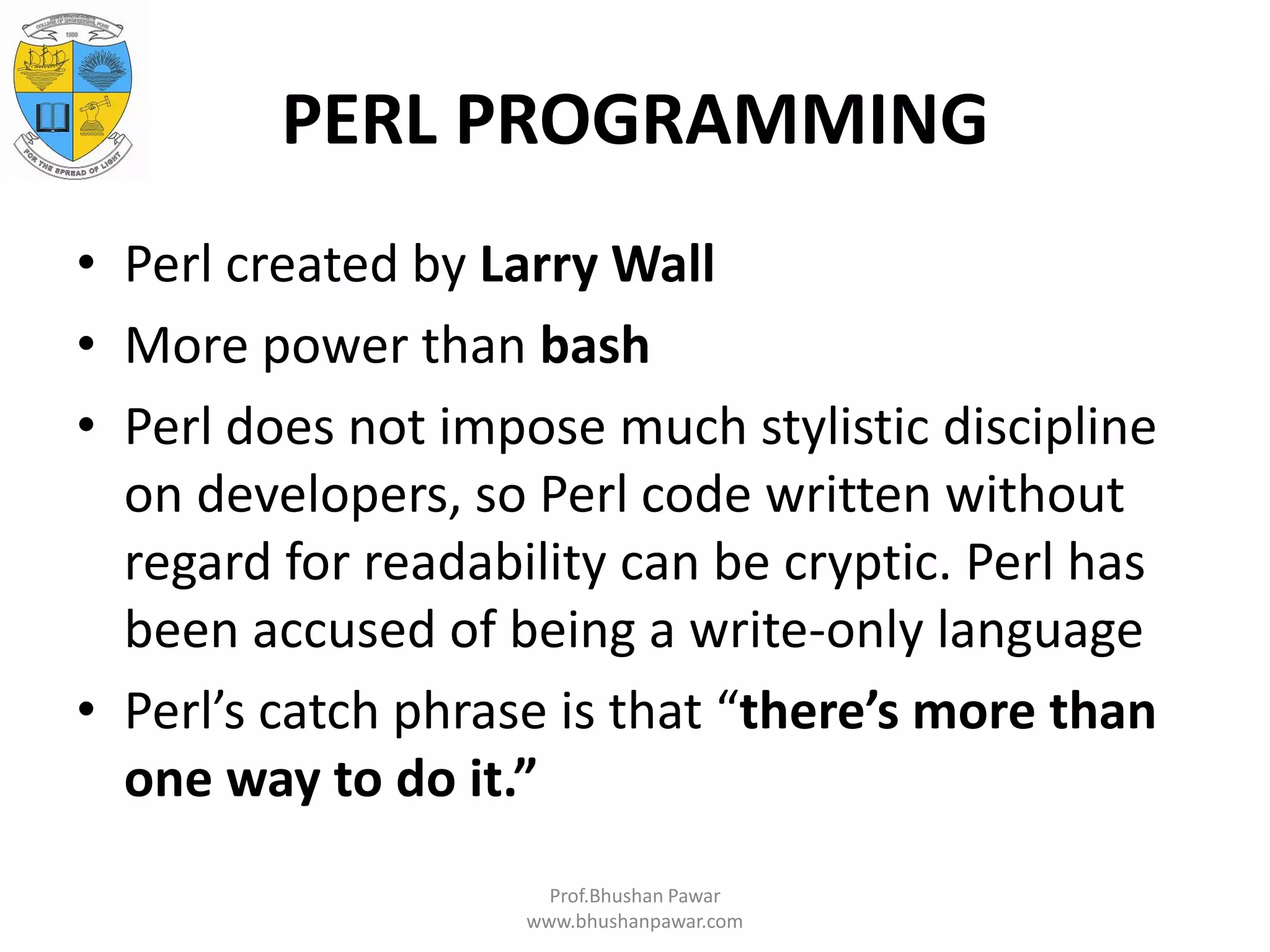
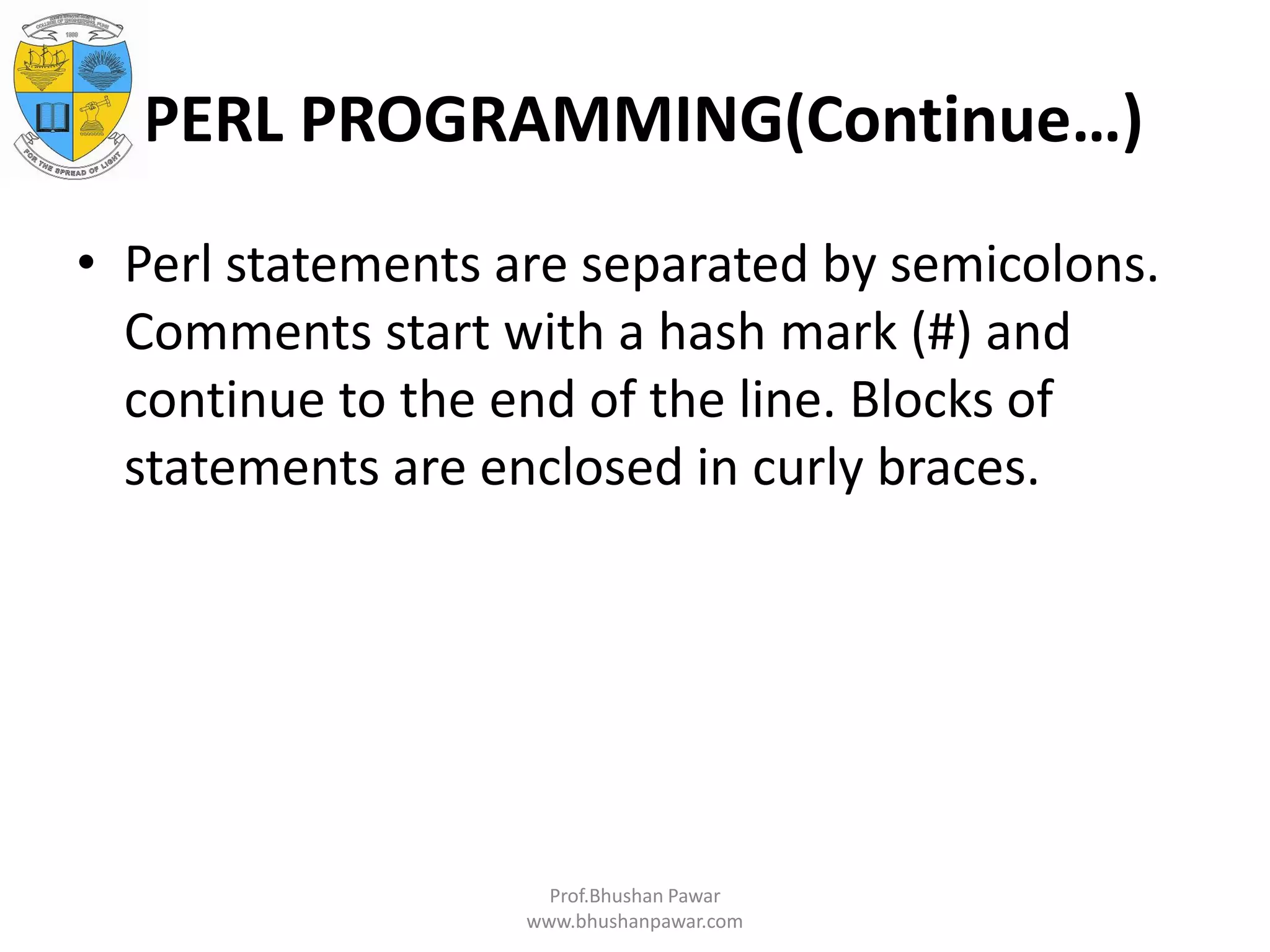


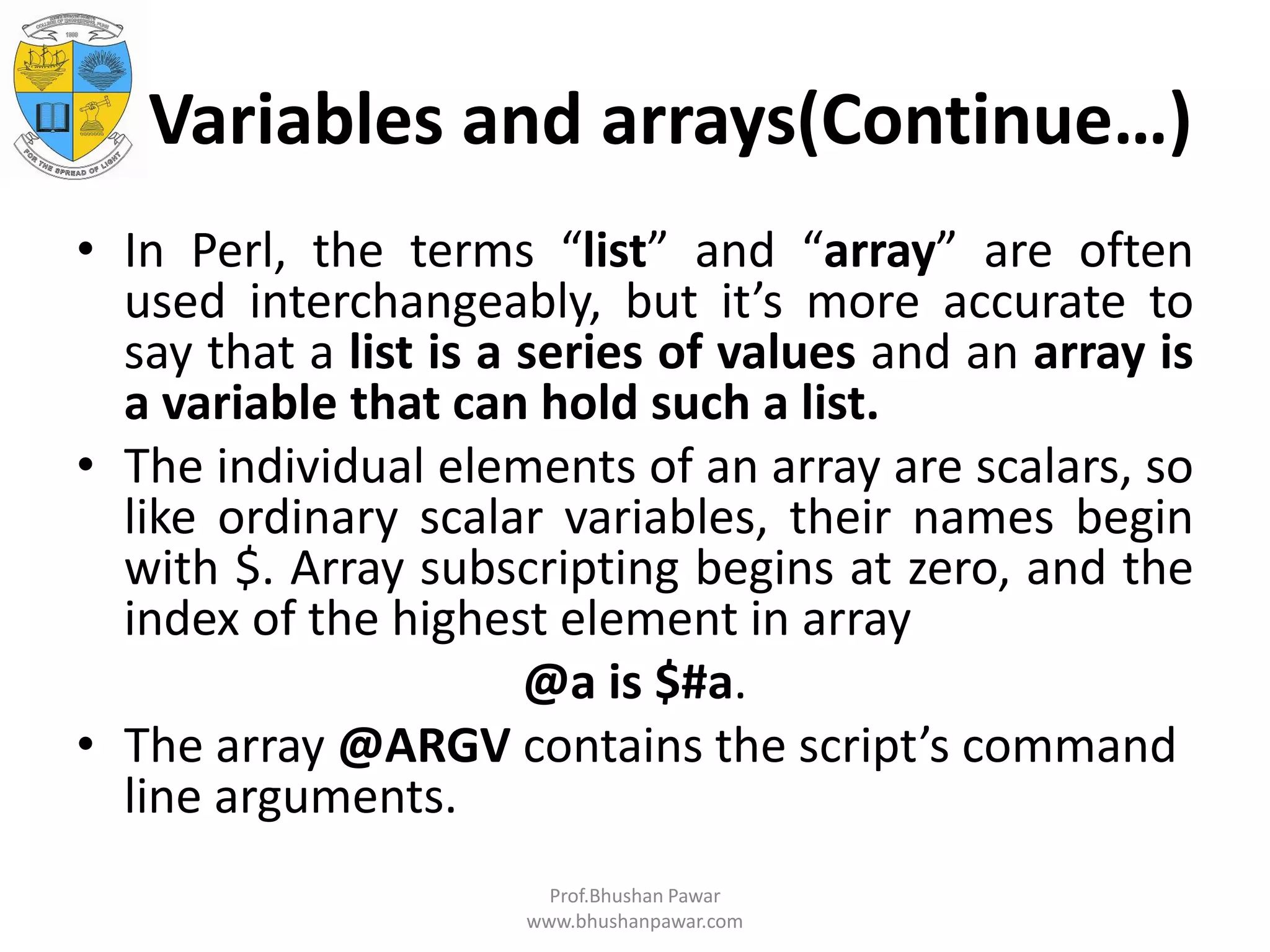
![Program #!/usr/bin/perl @items = ("socks", "shoes", "shorts"); printf "There are %d articles of clothing.n",$#items + 1; print "Put on ${items[2]} first, then ", join(" and ", @items[0,1]), ".n"; • The output: $ perl clothes There are 3 articles of clothing. Put on shorts first, then socks and shoes. Prof.Bhushan Pawar www.bhushanpawar.com](https://image.slidesharecdn.com/unit4-scriptingandtheshell-150713074847-lva1-app6891/75/Unit-4-scripting-and-the-shell-37-2048.jpg)
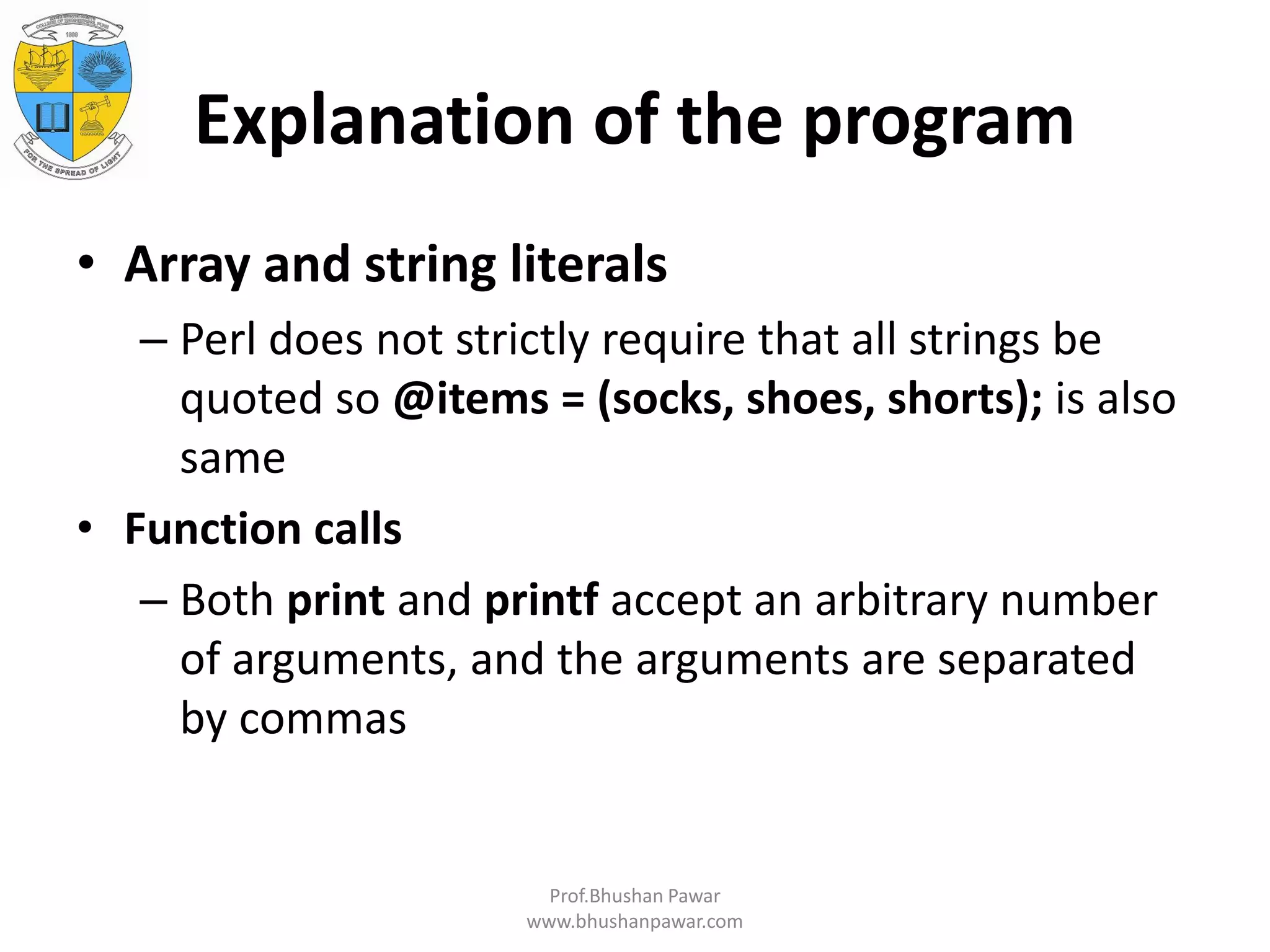
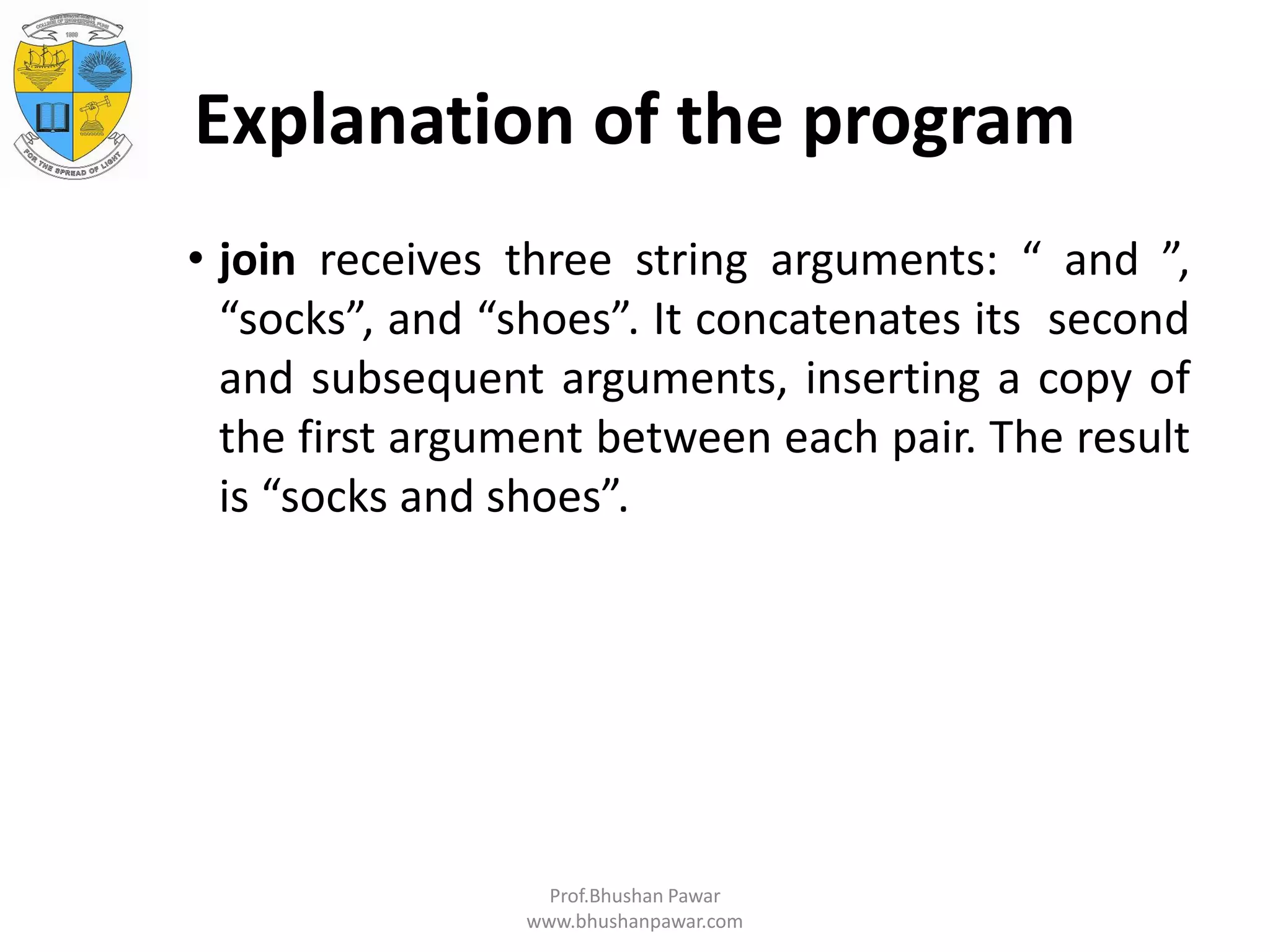

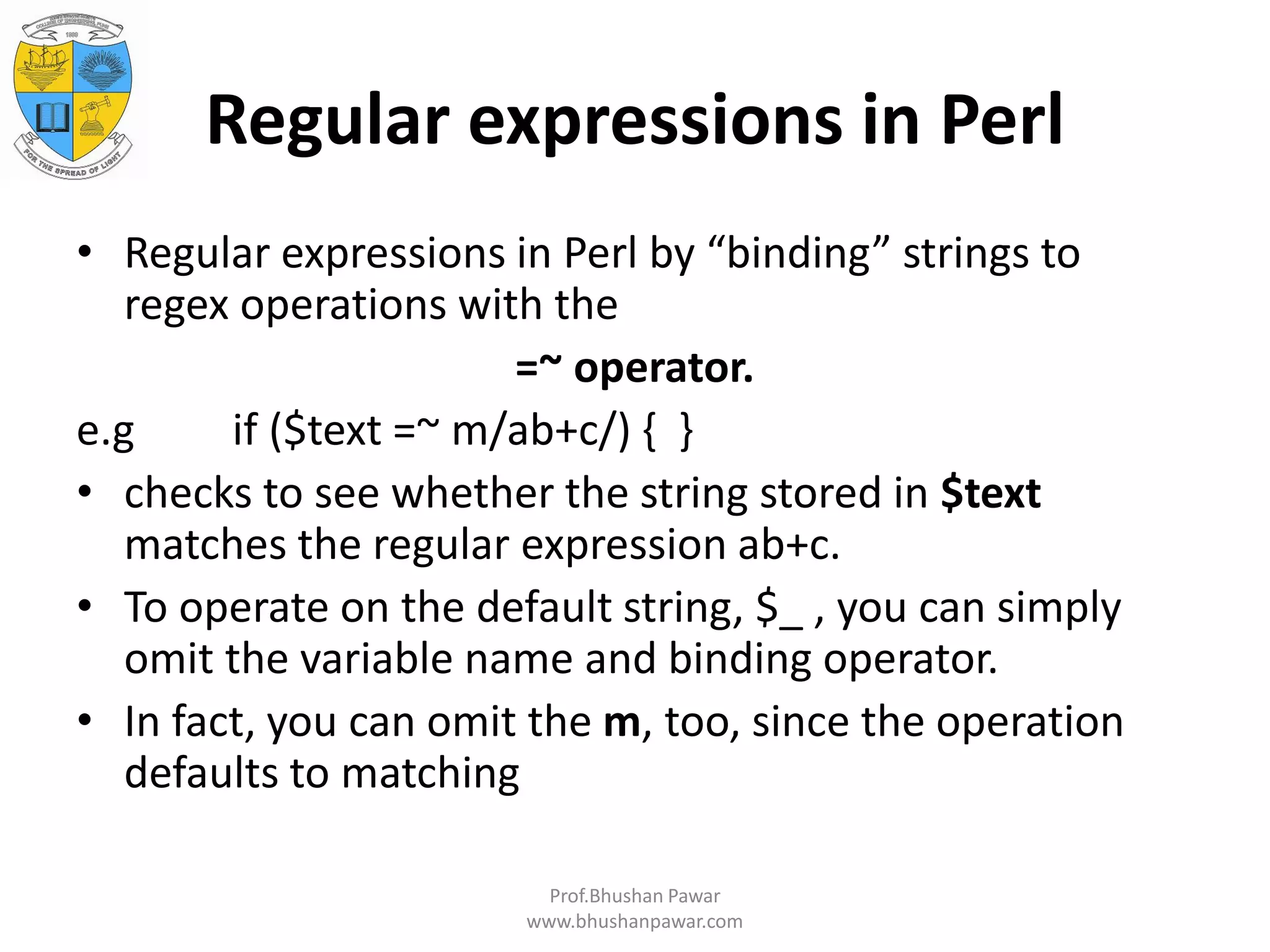
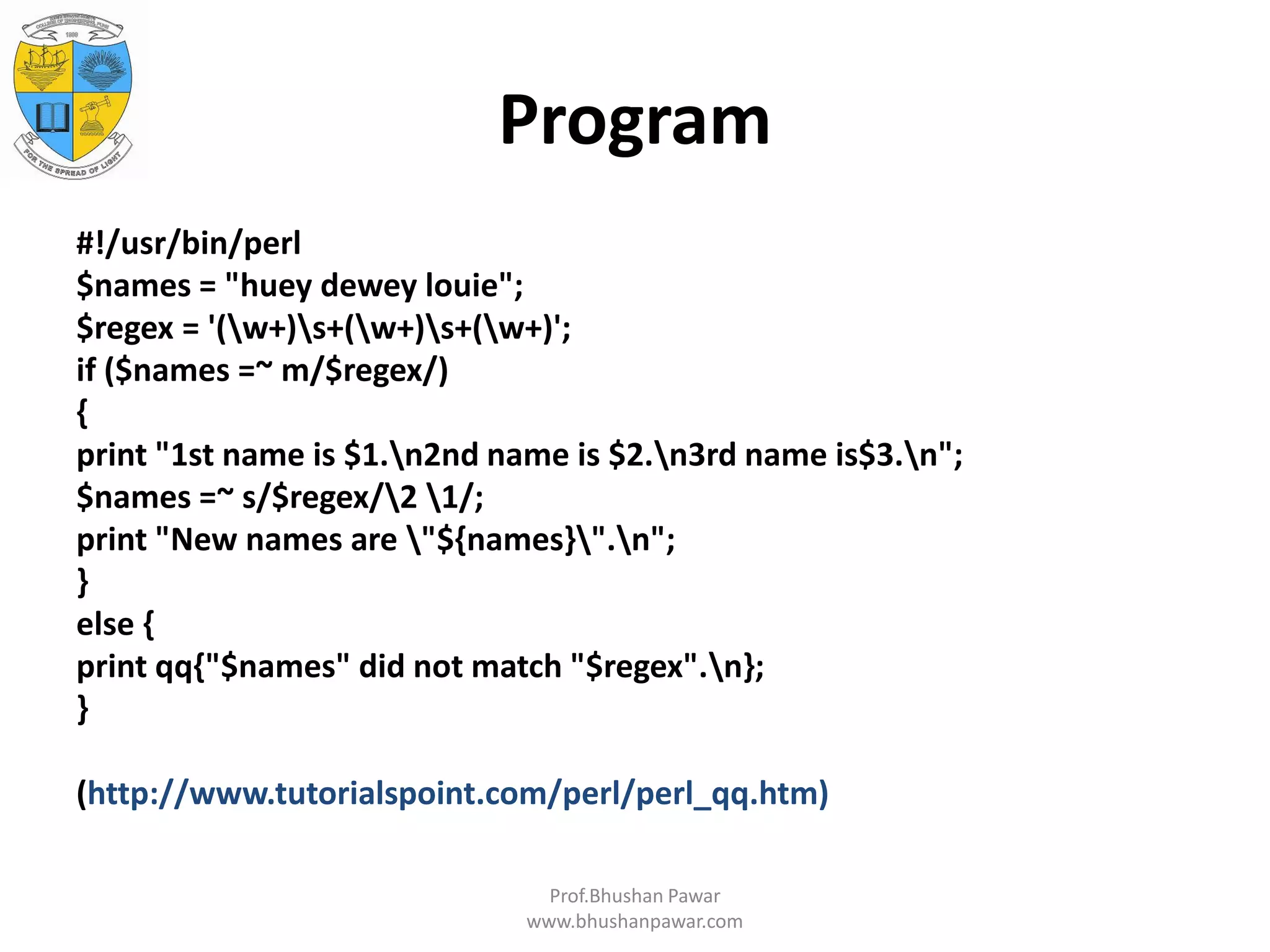
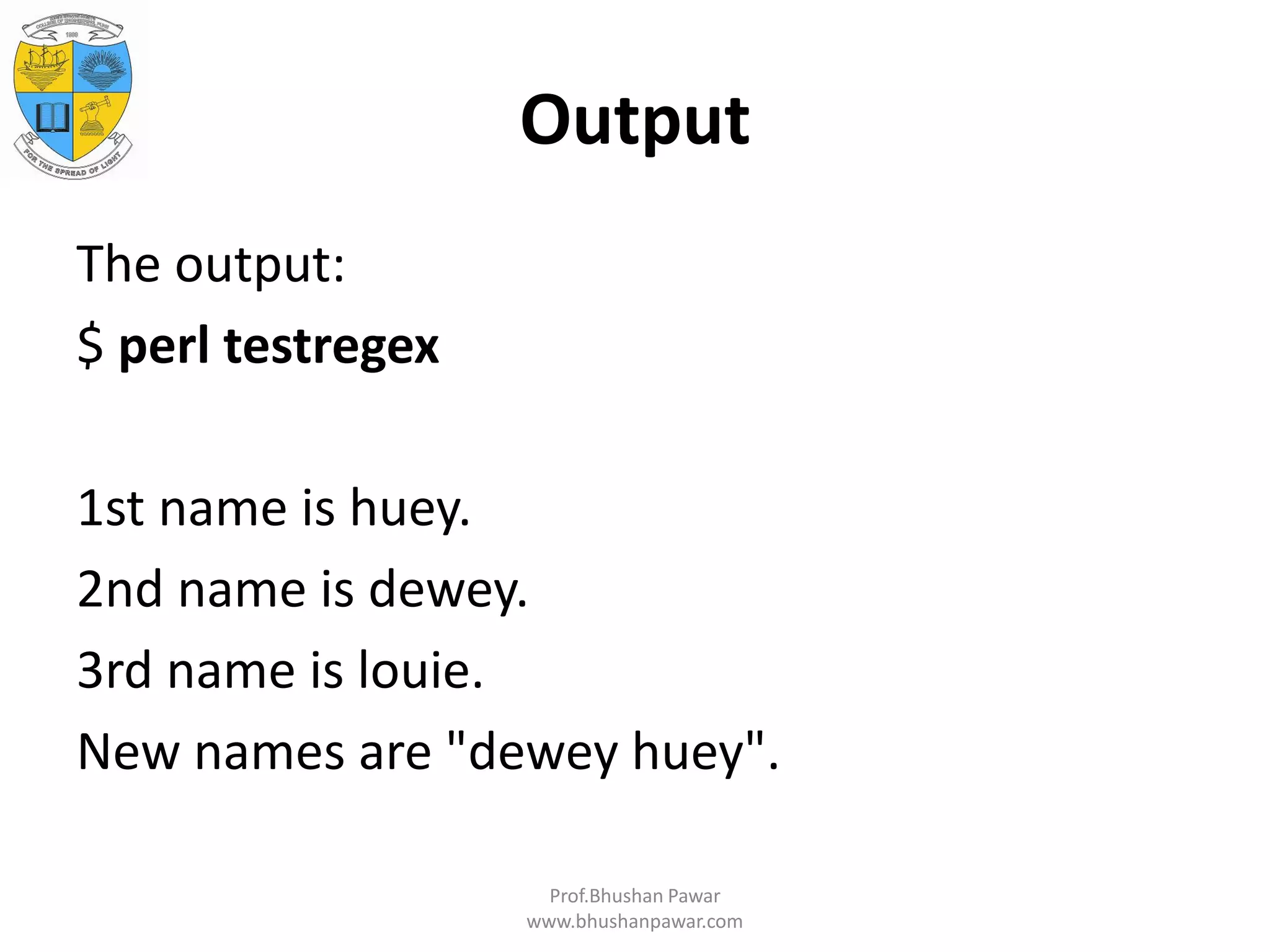
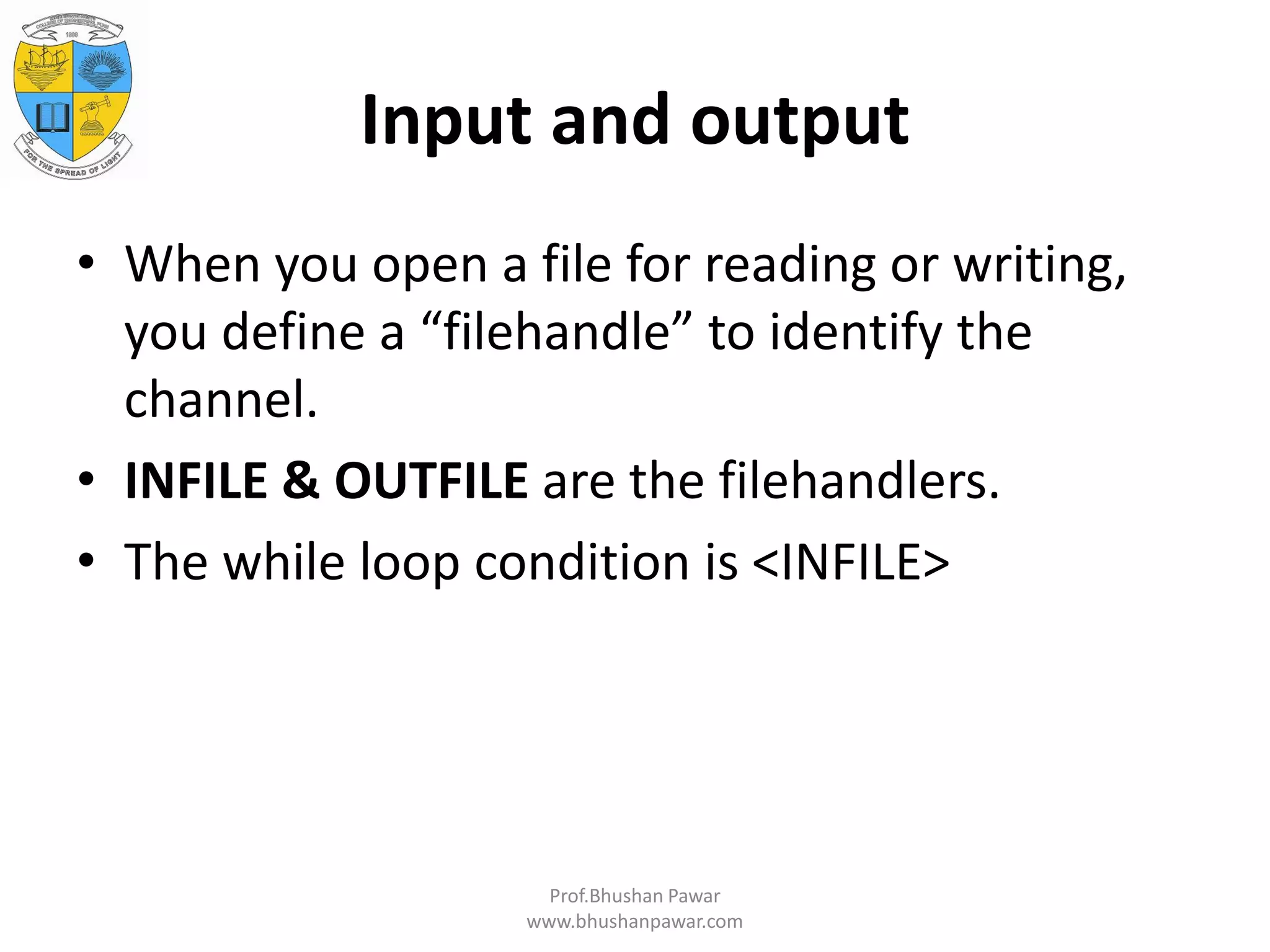
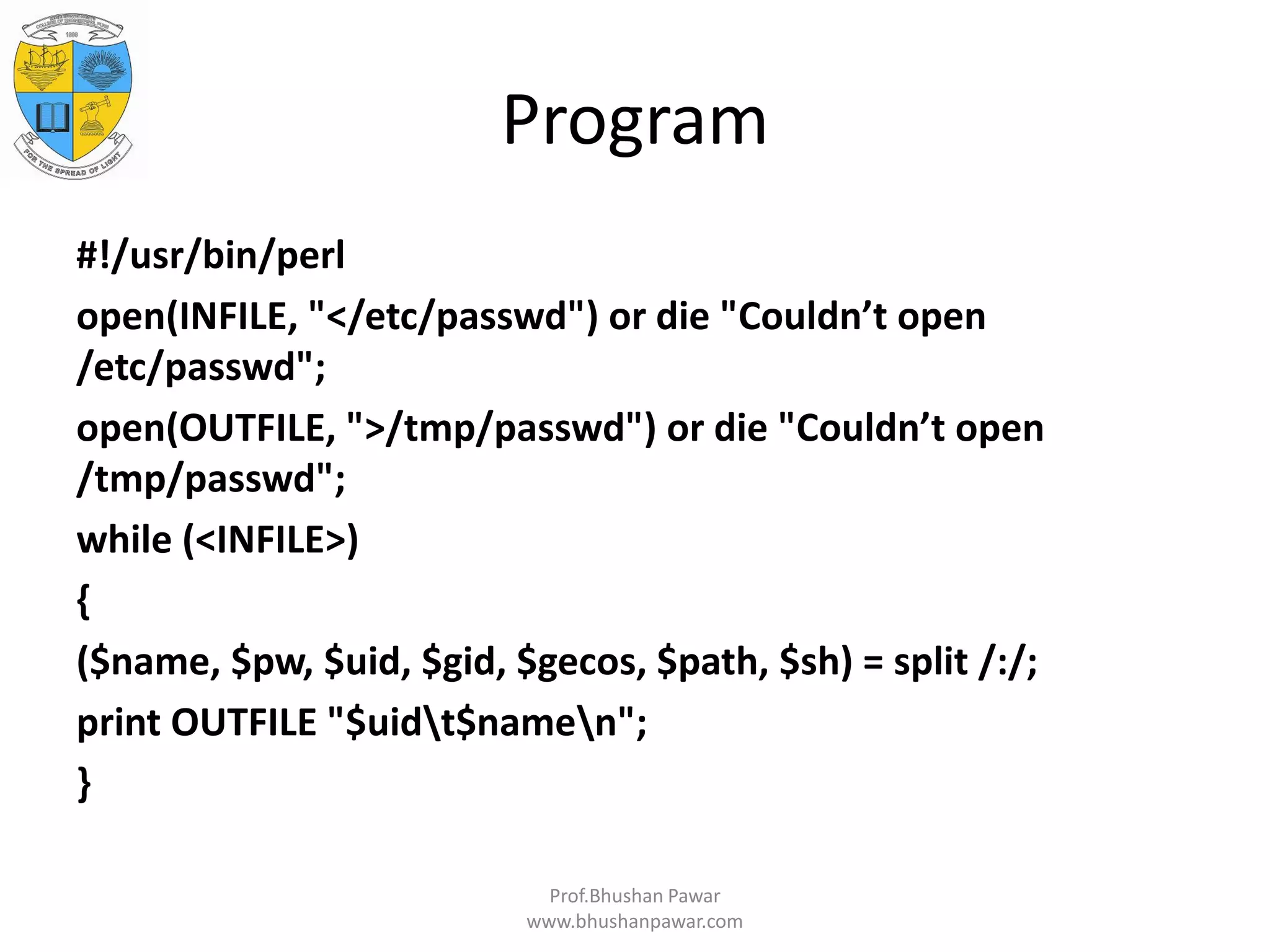

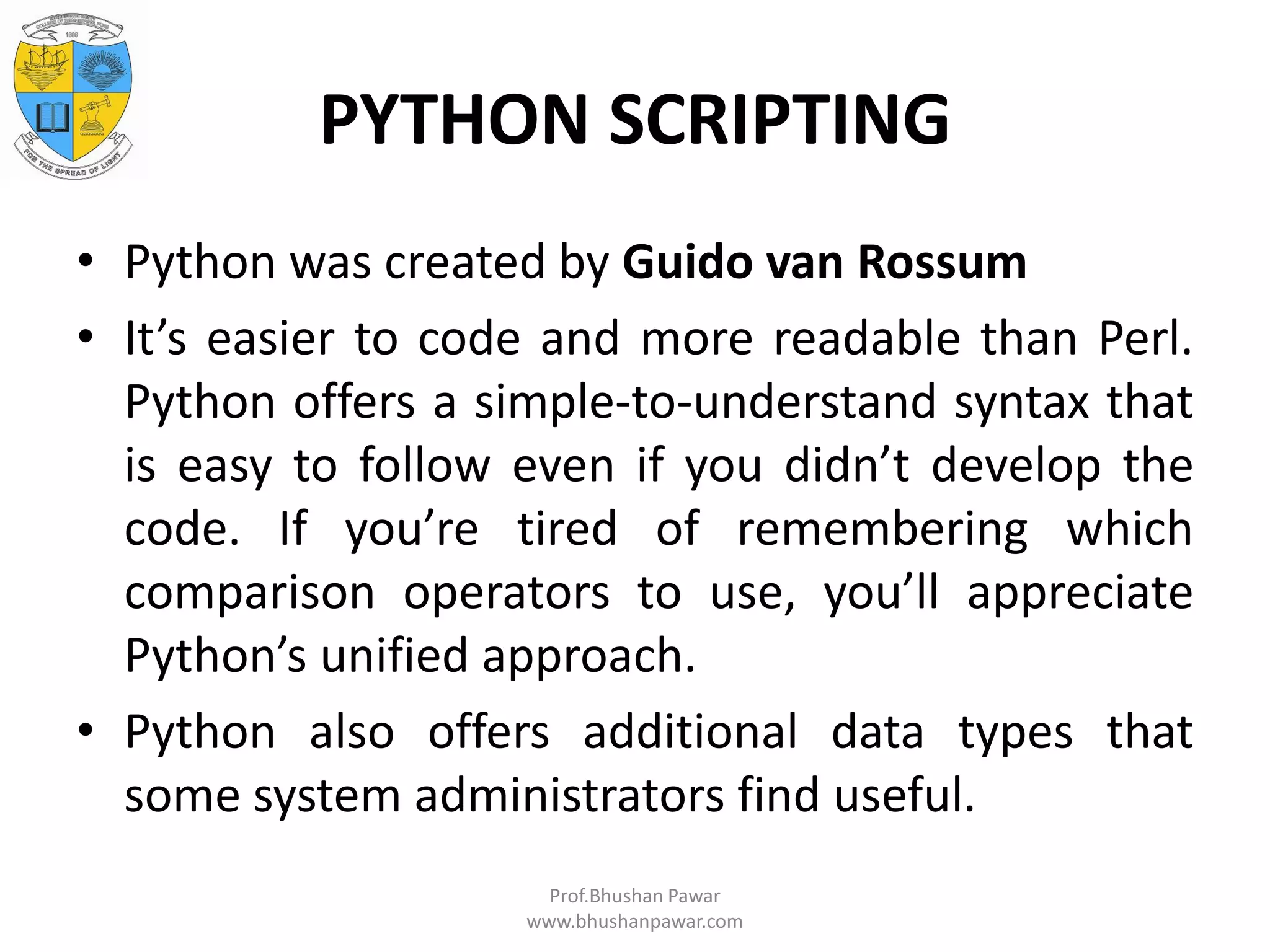

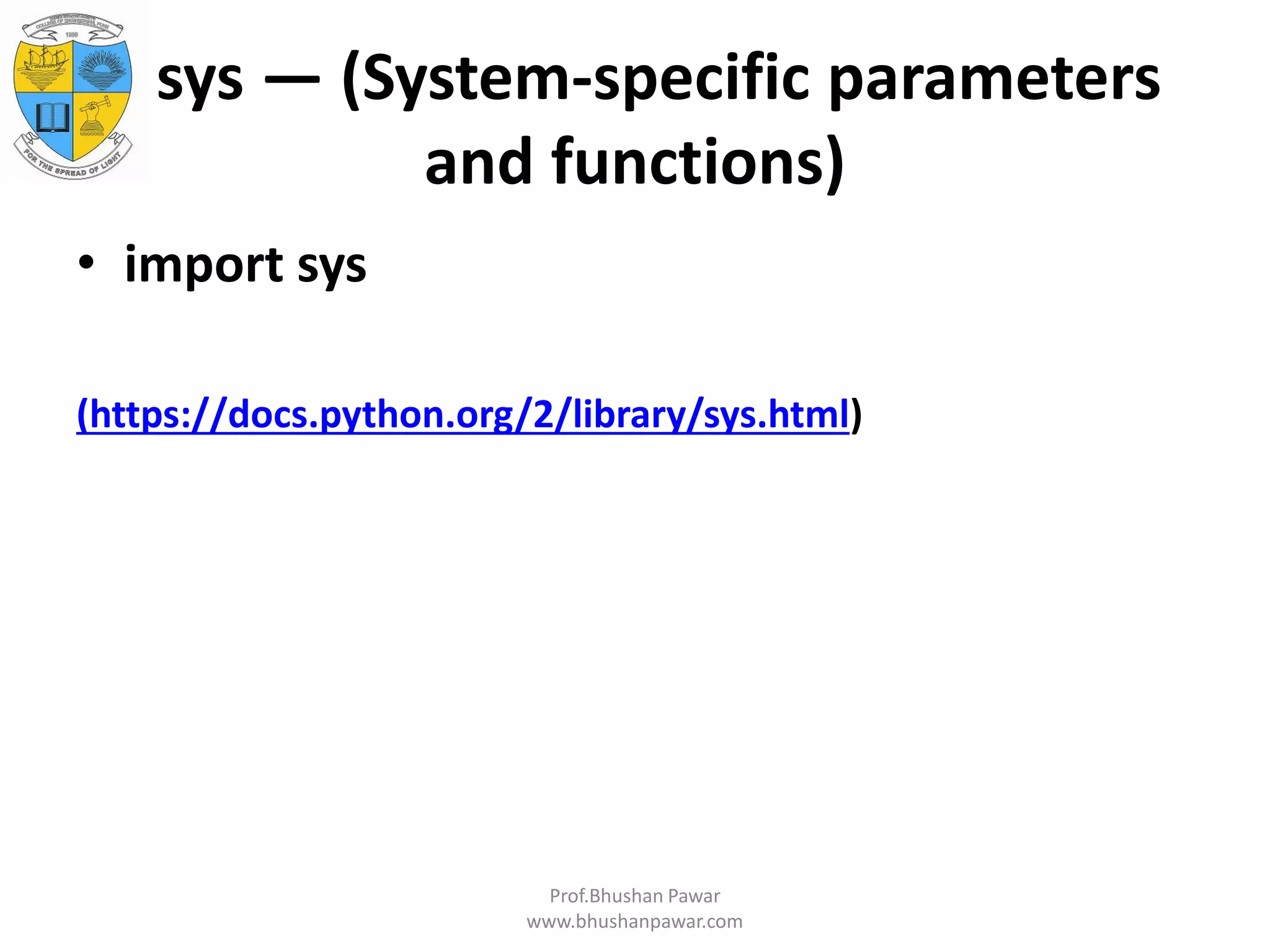
![Program #!/usr/bin/python name = 'Gwen' rating = 10 characters = [ 'SpongeBob', 'Patrick', 'Squidward' ] elements = ( 'lithium', 'carbon', 'boron' ) print "name:t%snrating:t%d" % (name, rating) print "characters:t%s" % characters print "elements:t%s" % (elements, ) This example produces the following output: $ python objects name: Gwen rating: 10 characters: ['SpongeBob', 'Patrick', 'Squidward'] elements: ('lithium', 'carbon', 'boron') Prof.Bhushan Pawar www.bhushanpawar.com](https://image.slidesharecdn.com/unit4-scriptingandtheshell-150713074847-lva1-app6891/75/Unit-4-scripting-and-the-shell-50-2048.jpg)

